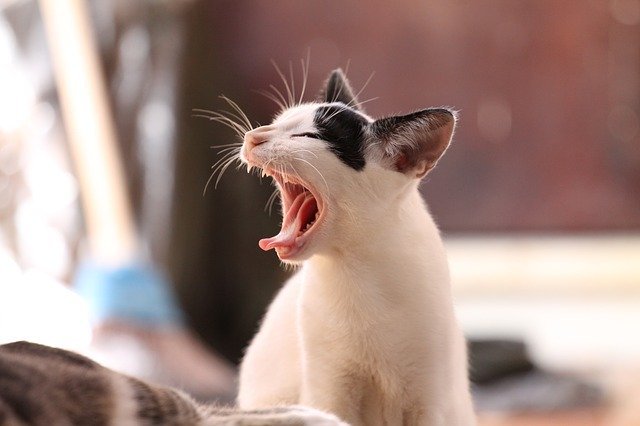While dogs regularly bark, growl, or woof at one another cats almost never have anything to say
to other cats – but get pretty chatty when it comes to the people in their lives.
There’s a real reason behind that.
Researchers have discovered that cats meow for very specific reasons, and almost all of those
reasons have to do with communicating with “their people”.
If your cat is meowing like crazy the odds are pretty good she’s trying to tell you something very specific.
Below we dig a little deeper into the nuts and bolts of exactly what your cat is trying to say
based on the type of meow she is making. These “translations” aren’t always an exact science.
But you’ll be able to much more effectively communicate with your cats from here on out if you
listen to the clues we highlight below.
Let’s dive right in!
What are Cats Really Saying When They Meow?
When a cat purrs, meows, or yells at a person that they are very clearly trying to get a point
across.
Unfortunately, for a bunch of different reasons, not all humans are clued into what these cats are
trying to say in the first place!
By focusing on how your cat is trying to communicate with you in the context of the situation,
though, you’ll be able to decipher what they’re trying to say with much better accuracy.
I’m Hungry!
Cats are not shy about telling you that they are hungry.
As soon as that little belly starts to rumble that they get pretty vocal, usually with a couple of
sharp meows mixed with a bit of purring. They are going to get in your face if they do not have
food in their bowl, and it’s going to happen right around normal breakfast or dinner time like
clockwork, too.
Context is key when they start to go on with this kind of chatter. If it’s around the time you
usually feed them and haven’t yet there’s a good chance their hunger has made them pretty
vocal. The distinct mixture of meows and purrs will be unique to your cat, but they’re pretty
consistent every time they are hungry.
Look for that kind of chatter and you’ll be able to figure out exactly what they mean and how to
remedy the situation!
[su_box title=”To help you even more”]I have covered a lot of the different cat meows to help you understand what your cat is saying. However, should you want a more in-depth and concise explanation of the feline meow then just click here to see our comprehensive guide. It is a must for all cat owners.[/su_box]
I’m Stressed Out
Stressed out cats are very vocal about their situation, something you probably know if you’ve
taken your cat for a ride to the vet a handful of times before.
This kind of chatter is usually pretty high-pitched, pretty drawn out, and pretty aggressive. They
want you to know that they aren’t happy, they are unsure, and the circumstances have them
unsettled.
Do your level best to calm them down whenever possible or two eliminate the stressor ASAP.
You’ll know that they are feeling better when they start to quiet down.
I’m Pretty Happy
Happy cats and kittens very rarely meow, instead opting to purr – almost like they are battery-
operated!
It’ll start is a gentle, low rumbling down in their stomach before it starts to spread up into their
throat and throughout their body until it feels like every inch of your cat is purring for you.
Scratch them behind the ears, rub their belly, and give them extra attention and you’ll get that
little motor going pretty quickly.
I’m Looking for Attention
If your cat pops up out of nowhere and starts meowing at random the chances are she just
wants a bit of attention.
For all their reputation for being pretty antisocial, the truth is cats can be pretty needy when it
comes to attention – as long as it’s on their terms.
A couple of belly rubs, a little bit of attention, and maybe a few minutes of playtime will usually
do the trick and quiet them down at the same time.
Different Sounds Mean Different Things
Aside from the actual context of your cats trying to communicate with you, it’s important to listen
to the sounds, they are making to get a better idea of what they are trying to say.
Different sounds will clue you into exactly how they are feeling. You’ll usually be able to
decipher what they are trying to say even if you are in the next room or barely within earshot.
Quick Meow
A quick meow, usually upon greeting you, is almost exclusively just a sign of saying hello.
This is just a cat’s way of telling you that they recognize you, that they notice you, and that they
are glad that you are back. This can also be a quick sign of a cat needing a little bit of attention,
especially if they start to jump up into your lap or your space.
Very rarely are quick meows (especially singular meows) tied to anything related to bad news or
distress.
Rapid Fire Meows
Rapid-fire meows are very much attention-seeking. You want to be on the lookout for how and
when your cat is sending them your way.
If your cat hasn’t seen you in a while (you been away at work or school) maybe they are just
really excited to see you again. These rapid-fire meows will almost always be combined with
rubbing up against you, purring, and other signs that they are just glad to have you around.
If these rapid-fire meows seemingly start out of nowhere or are attached to obvious signs of
distress or anxiety than they usually mean something’s wrong in the eyes of your cat or kitten.
They are letting you know that something’s up, there’s something that you should be paying
attention to, and that there’s something that they want you to focus on ASAP.
Drawn Out Meows
Long, drawn-out meows are almost always associated with your cat demanding something of
you.
Maybe they need you to hurry up and refill their food or water bowl. Maybe they need you to let
them out (or let them in). Maybe they just need you to start paying attention to them when the
short burst of meows didn’t work.
Long, extended, drawn-out meows are a cry for attention. They want you to listen to what they
have to say.
Lower Pitch Meows
Low pitch meows are often thought of as “complaints”, with a lot of researchers associating
them with your cat somehow being upset with you. If you’ve done something that they aren’t
happy with – pet them for too long, made them go without food for too long, haven’t let them out
in time, etc. – this is the kind of sound you be met with.
High Pitch, Sharp Meows
Higher pitch, sharp, extreme meows are almost always linked to pain, fear, stress, or injury.
If you’ve ever stepped on your cat’s tail accidentally you know exactly what we are talking” href=”https://sprayingcats.com/cat-talking-to-owner-what-are-they-saying/”>talking
about. Those kinds of meows are cries for help, cries of surprise, and cries of pain or fear. They
mean that your cat needs help in a hurry.
Hiss
Not all cat communication is handled through meows.
If you hear your furry little family member start to sound like a fresh steak hitting a hot cast-iron
pan, sizzling away, the odds are good that they are hissing at something and they aren’t happy.
Cats that hiss almost always combine this form of communication with changed physiology.
They arch their back, their hair puffs out, their tail starts to twitch, and they show obvious signs
of aggression or fear.
Yowl
Cats usually communicate with one another in the form of yowls, almost always communicating
this way when mating season is upon them. Very rarely will you have a cat start to hit you with a
lot of yowls?
Every now and again, though, cats might start to make this sound when they are bored or when
they are somewhere new. If your cat does start to make this sound on a consistent basis without
an obvious reason behind it they may have an injury that needs to be checked out.
Get them to the vet ASAP for a closer inspection.
Screech
Screeching usually only happens in the middle of a fight. This is an obvious sign of aggression,
anger, and fear all mixed into one.
Rarely will humans get screeched at? Instead, cats screech at one another to try and end the
fight when it is getting particularly tense. They can also lead any of their attacks with a screech,
looking to unsettle the cat that they are going to throw down with.
Growl or Snarl
Growls and snarls usually precede a catfight as well. Your cat’s physiology will change (back up
and arched, hair puffed up, ears back, and tail twitching) when they start to make this noise.
It’s best to leave your cat alone when they start to growl and snarl if at all possible. Try to
remove the object of their anxiety and fear if you can do it safely. Just be sure to give them
plenty of time to cool down before you approach them again.
Closing Thoughts
At the end of the day, all the inside information about can help you better communicate with
your cat and kittens from here on out.
No, this doesn’t mean you have to start speaking their language and meow, hiss, or start purring
at them when you want to get your message across. But by better understanding what they
mean when they make noise you will be able to take care of their needs and keep them happy
and healthy from here on out.
It doesn’t get much better than that!
[su_box title=”Affiliate Disclosure”]This website is supported by its readers. Please assume that all links are affiliate links. If you make a purchase from one of the links we will make a commission from Amazon. Thank you.[/su_box]





